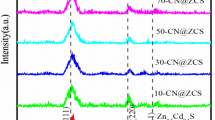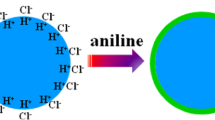Abstract
As p–n heterojunction photocatalysts usually possess dramatically improved photocatalytic activity than single photocatalysts, a novel ZnO/Cu2O heterojunction was designed by a facile self-templating method in this study. The crystal structure, chemical composition, surface morphology, and optical property of ZnO/Cu2O heterojunction were investigated to clarify the structure-property correlation. Scanning electron microscope and transmission electron microscope images proved the uniform core-shell submicrospheres of ZnO/Cu2O, in which a three-dimensional flower-like ZnO core was coated by a shell comprised of Cu2O nanoparticles. The photoresponse result showed that the band gap of the ZnO/Cu2O core-shell submicrospheres became narrow, and the absorption edge shifted from the ultraviolet region (380 nm) to the visible region (500 nm) compared with the pure ZnO microflowers. For the degradation of Rhodamine B under visible light, the photocatalytic efficiency of ZnO/Cu2O submicrospheres reached 96% within 40 min of reaction time, which was 3.8 times higher than that of pure ZnO microflowers and up to 4.5 times than that for pure Cu2O nanoparticles. The remarkable visible light-driven photocatalytic performance is mainly attributed to the extended photoresponse range and effective separation of the photo-generated electron-hole pairs in the unique heterojunction.

ZnO/Cu2O core-shell microspheres for the degradation of RhB under visible light
Highlights
-
A novel core-shell ZnO/Cu2O heterojunction was synthesized by a facile self-templating method.
-
Core-shell ZnO/Cu2O submicrospheres were comprised of three-dimensional flowerlike ZnO core coated by a shell of Cu2O nanoparticles.
-
The band gap of ZnO/Cu2O submicrospheres became narrow and the absorption edge shifted to the visible region.
-
ZnO/Cu2O submicrospheres exhibited better visible light-driven photocatalytic performance than pure ZnO or Cu2O.










Similar content being viewed by others
References
Fujishima A, Honda K (1972) Electrochemical photolysis of water at a semiconductor electrode. Nature 238:37–38
Zhang L, Hu JS, Huang XH, Song J, Lu SY (2018) Particle-in-box nanostructured materials created via spatially confined pyrolysis as high performance bifunctional catalysts for electrochemical overall water splitting. Nano Energy 48:489–499
Li XW, Xu HF, Wang L, Zhang L, Cao XF, Guo YC (2018) Spinel NiFe2O4 nanoparticles decorated BiOBr nanosheets for improving the photocatalytic degradation of organic dye pollutants. J Taiwan Inst Chem E 85:257–264
Clifford JN, Palomares E, Nazeeruddin MK, Thampi R, Gratzel M, Durrant JR (2004) Multistep electron transfer processes on dye co-sensitized nanocrystalline TiO2 films. J Am Chem Soc 126:5670–5671
Chen CC, Ma WH, Zhao JC (2010) Semiconductor-mediated photodegradation of pollutants under visible- light irradiation. Chem Soc Rev 39:4206–4219
Zhang L, Hu JS, Huang XH, Song J, Lu SY (2018) Ag nanoparticle-decorated biscuit-like Bi24O31Cl10 hierarchical microstructure composed of ultrathin nanoflake with outstanding photocatalytic activity. J Alloy Compd 735:660–667
Zeng JH, Jin BB, Wang YF (2009) Facet enhanced photocatalytic effect with uniform single-crystalline zinc oxide nanodisks. Chem Phys Lett 472:90–95
Gao P, Chen YJ, Wang Y, Zhang Q, Li XF, Hu M (2009) A simple recycling and reuse hydrothermal route to ZnO nanorod arrays, nanoribbon bundles, nanosheets, nanocubes and nanoparticles. Chem Commun 19:2762–2764
Park WI, Kim DH, Jung SW, Yi GC (2002) Metalorganic vapor-phase epitaxial growth of vertically well-aligned ZnO nanorods. Appl Phys Lett 80:4232–4232
Li Y, Meng GW, Zhang LD, Phillipp F (2000) Ordered semiconductor ZnO nanowire arrays and their photoluminescence properties. Appl Phys Lett 76:2011–2013
Yao MS, Hu P, Cao YB, Xiang WC, Zhang X, Yuan FL, Chen YF (2013) Morphology-controlled ZnO spherical nanobelt-flower arrays and their sensing properties. Sen Act B 177:562–569
Liu C, Zapien JA, Yao Y, Meng X, Lee CS, Fan S, Lifshitz Y, Lee ST (2003) High-density, ordered ultraviolet light-emitting ZnO nanowire arrays. Adv Mater 15:838–841
Bendall JS, Visimberga G, Szachowicz M, Plank NOV, Romanov S, Sotomayor-Torres CM, Welland ME (2008) An investigation into the growth conditions and defect states of laminar ZnO nanostructures. J Mater Chem 18:5259–5266
Vayssieres L, Keis K, Lindquist SE, Hagfeldt A (2001) Purpose-built anisotropic metal oxide material: 3D highly oriented microrod array of ZnO. J Phys Chem B 105:3350–3352
Li ZQ, Ding Y, Xiong YJ, Yang Q, Xie Y (2004) Room-temperature surface-erosion route to ZnO nanorod arrays and urchin-like assemblies. Chem Eur J 10:5823–5828
Vayssieres L (2003) Growth of arrayed nanorods and nanowires of ZnO from aqueous solutions. Adv Mater 15:464–466
Cho S, Jang JW, Lee JS, Lee KH (2010) Carbon-doped ZnO nanostructures synthesized using vitamin C for visible light photocatalysis. CrystEngComm 12:3929–3935
Wu F, Tian LM, Kanjolia R, Singamaneni S, Banerjee P (2013) Plasmonic metal-to-semiconductor switching in Au nanorod-ZnO nanocomposite films. ACS Appl Mater Interfaces 5:7693–7697
Kohnehpoushi S, Eskandari M, Anejand B, Ahmadi V (2016) Numerical calculation of plasmonic field absorption enhancement in CdSe-quantum dot sensitized ZnO nanorods by Ag nanoparticle periodic arrays. Opt Mater 62:90–94
Azizi S, Mohamad R, Rahim RA, Moghaddam AB, Moniri M, Ariff A, Saad WZ, Namvab F (2016) ZnO-Ag core shell nanocomposite formed by green method using essential oil of wild ginger and their bactericidal and cytotoxic effects. Appl Surf Sci 384:517–524
Tao JJ, Gong ZZ, Yao G, Cheng YL, Zhang M, Lv JG, Shi SW, He G, Jiang XS, Chen XS, Sun ZQ (2016) Enhanced optical and photocatalytic properties of Ag quantum dots-sensitized nanostructured TiO2/ZnO heterojunctions. J Alloy Compd 688:605–612
Yang YQ, Li HX, Hou FL, Hu JY, Zhang XD, Wang YX (2016) Facile synthesis of ZnO/Ag nanocomposites with enhanced photocatalytic properties under visible light. Mater Lett 180:97–100
Wang Y, Wang Q, Zhan X, Wang F, Safdar M, He J (2013) Visible light driven type II heterostructures and their enhanced photocatalysis properties: a review. Nanoscale 5:8326–8339
Tao JJ, Gong ZZ, Yao G, Cheng YL, Zhang M, Lv JG, Shi SW, He G, Jiang XS, Chen XS, Sun ZQ (2016) Enhanced photocatalytic and photoelectron chemical properties of TiO2 nanorod arrays sensitized with CdS nanoplates. Ceram Int 42:11716–11723
Li X, Xia T, Xu C, Murowchick J, Chen X (2014) Synthesis and photoactivity of nanostructured CdS-TiO2 composite catalysts. Catal Today 225:64–73
Xie Z, Liu X, Wang W, Wang X, Liu C, Xie Q, Li Z, Zhang Z (2015) Enhanced photoelectron chemical and photocatalytic performance of TiO2 nanorod arrays/CdS quantum dots by coating TiO2 through atomic layer deposition. Nano Energy 11:400–408
Zou CW, Rao YF, Alyamani A, Chu W, Chen MJ, Patterson DA, Emanuelsson EAC, Gao W (2010) Heterogeneous lollipop-like V2O5/ZnO array: a promising composite nanostructure for visible light photocatalysis. Langmuir 26:11615–11620
Zoolfakar AS, Rani RA, Morfa AJ, O’Mullane AP, Kalantar-zadeh K (2014) Nanostructured copper oxide semiconductors: a perspective on materials, synthesis methods and applications. J Mater Chem C 2:5247–5270
Wei A, Xiong L, Sun L, Liu YJ, Li WW (2013) CuO nanoparticle modified ZnO nanorods with improved photocatalytic activity. Chin Phys Lett 30:365–367
Cho S, Jang JW, Lee JS, Lee KH (2012) Porous ZnO-ZnSe nanocomposites for visible light photocatalysis. Nanoscale 4:2066–2071
Akhavan O, Tohidi H, Moshfegh AZ (2009) Synthesis and electrochromic study of sol-gel cuprous oxide nanoparticles accumulated on silica thin film. Thin Solid Films 517:6700–6706
Akhavan O, Hasani E (2011) Copper oxide nanoflakes as highly sensitive and fast response self-sterilizing biosensors. J Mater Chem 21:12935–12940
Park JC, Kim J, Kwon H, Song H (2009) Gram-scale synthesis of Cu2O nanocubes and subsequent oxidation to CuO hollow nanostructures for lithium-ion battery anode materials. Adv Mater 21:803–807
Akhavan O, Azimirad R, Safad S, Hasani E (2011) CuO/Cu(OH)2 hierarchical nanostructures as bactericidal photocatalysts. J Mater Chem 21:9634–9640
Akhavan O, Hasani E (2010) Cu and CuO nanoparticles immobilized by silica thin films as antibacterial materials and photocatalysts. Surf Coat Tech 205:219–223
Li BX, Wang YF (2010) Facile synthesis and enhanced photocatalytic performance of flower-like ZnO hierarchical microstructures. J Phys Chem C 114:890–896
Wang YF, Li BX, Xu CY (2012) Fabrication of superhydrophobic surface of hierarchical ZnO thin films by using stearic acid. Superlattices Microstruct 51:128–134
Poulston S, Parlett PM, Stone P, Bowker M (1996) Surface oxidation and reduction of CuO and Cu2O studied using XPS and XAES. Surf Interface Anal 24:811–820
Tian Q, Li J, Xie Q, Wang Q (2012) Morphology-tuned synthesis of arrayed one dimensional ZnO nanostructures from Zn(NO3)2 and dimethylamine borane solutions and their photoluminescence and photocatalytic properties. Mater Chem Phys 132:652–658
Wang MY, Sun L, Lin ZQ, Cai JH, Xie KP, Lin CJ (2013) P–n heterojunction photoelectrodes composed of Cu2O-loaded ZnO nanotube arrays with enhanced photoelectrochemical and photoelectrocatalytic activities. Energy Environ Sci 6:1211–1220
Tahir D, Tougaard S (2012) Electronic and optical properties of Cu, CuO and Cu2O studied by electron spectroscopy. J Phys Condens Matter 24:175002–175009
Yu JG, Yu XX (2008) Hydrothermal synthesis and photocatalytic activity of zinc oxide hollow spheres. Environ Sci Technol 42:4902–4907
Wang JC, Zhang L, Fang WX, Ren J, Li YY, Yao HC, Wang JS, Li ZJ (2015) Enhanced photoreduction CO2 activity over direct z-scheme α-Fe2O3/Cu2O heterostructures under visible light irradiation. ACS Appl Mater Interfaces 7:8631–8639
Kandjani AE, Sabri YM, Periasamy SR, Zohora N, Amin MH, Nafady A, Bhargava SK (2015) Controlling core/shell formation of nanocubic p-Cu2O/n-ZnO toward enhanced photocatalytic performance. Langmuir 31:10922–10930
Acknowledgements
This work was financially supported by the National Natural Science Foundation of China (No. 51772003, 51472003, 51702003, 51701001), Provincial Natural Science Foundation of Anhui Higher Education Institution of China (No. KJ2017A002).
Author information
Authors and Affiliations
Corresponding author
Ethics declarations
Conflict of interest
The authors declare that they have no conflict of interest.
Rights and permissions
About this article
Cite this article
Wang, Y., Gao, J., Wang, X. et al. Facile synthesis of core-shell ZnO/Cu2O heterojunction with enhanced visible light-driven photocatalytic performance. J Sol-Gel Sci Technol 88, 172–180 (2018). https://doi.org/10.1007/s10971-018-4786-8
Received:
Accepted:
Published:
Issue Date:
DOI: https://doi.org/10.1007/s10971-018-4786-8




